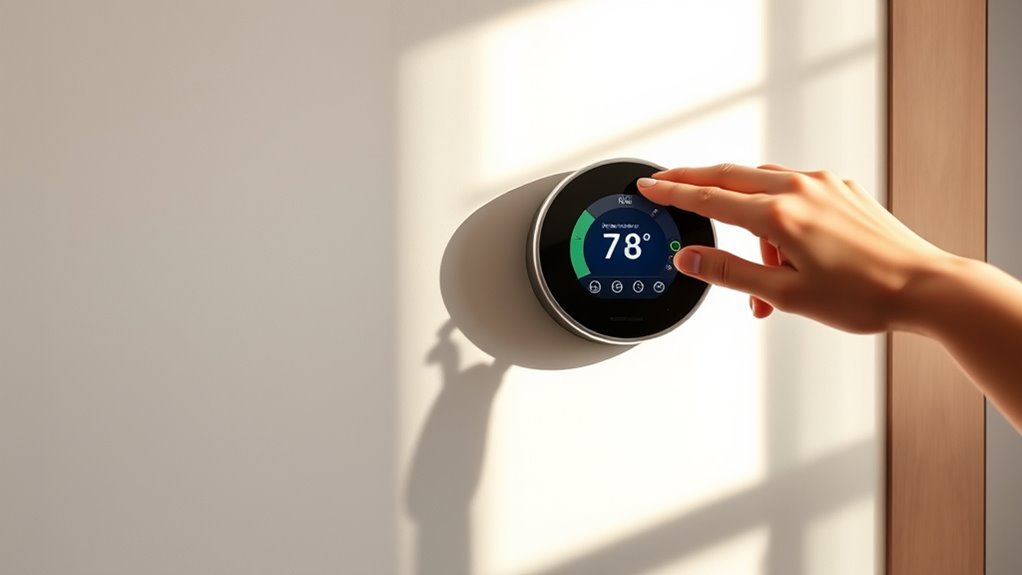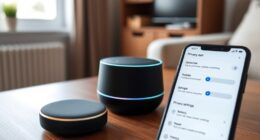Smart thermostat scheduling helps you save energy and reduce utility bills by automatically adjusting temperatures based on your routines. You can set specific times for heating and cooling, ensuring comfort when you need it and savings when you don’t. Many smart thermostats learn your habits and adapt over time for even better efficiency. By customizing zones and schedules, you’ll optimize comfort and savings effortlessly. If you keep exploring, you’ll discover more ways to make your home smarter and more efficient.
Key Takeaways
- Set schedules to reduce heating/cooling during unoccupied hours, lowering energy consumption and utility bills.
- Use personalized routines and adaptive learning features to optimize comfort and efficiency automatically.
- Program zone-specific temperature settings to focus energy on main living areas and avoid waste in unused spaces.
- Automate temperature adjustments before arrival or wake-up to ensure comfort without unnecessary energy use.
- Combine scheduling with energy-efficient hardware and sensors for enhanced savings and smarter climate control.

Have you ever wondered how to save energy and cut costs while keeping your home comfortable? Smart thermostat scheduling makes this possible by allowing you to optimize your heating and cooling patterns. When you set your thermostat to work smarter, you not only reduce your energy consumption but also tailor your environment to suit your lifestyle. This is where energy savings and user customization come into play, giving you control over your home’s climate with minimal effort.
With a smart thermostat, you can program specific temperature settings for different times of the day and week. For example, you might set the temperature lower during your work hours or when you’re asleep, then increase it just before you arrive home or wake up. This proactive approach ensures you’re not wasting energy when you don’t need heating or cooling, leading to noticeable savings on your utility bills. Instead of manually adjusting your thermostat each day, you let the device handle the scheduling, freeing you from guesswork and constant adjustments.
Program your thermostat to save energy by scheduling temperatures for different times of the day and week.
User customization is a key feature that makes smart thermostat scheduling so effective. You can create personalized schedules that fit your routine perfectly. If you have irregular hours or weekend plans, many models allow you to tweak settings on the fly through a smartphone app. This flexibility means your home is always maintained at an ideal comfort level without sacrificing energy efficiency. Plus, some smart thermostats learn your habits over time, automatically adjusting schedules based on your preferences, further enhancing energy savings and convenience.
Another advantage of user customization is the ability to set different zones within your home. If certain areas are rarely used, you can program the thermostat to keep those spaces at a lower temperature or turn them off entirely when not needed. This targeted approach maximizes energy savings without compromising the comfort of your main living spaces. Additionally, pairing your smart thermostat with sensors or other smart devices lets you fine-tune your climate control even further, ensuring each room stays just right.
In essence, smart thermostat scheduling empowers you with energy-efficient control tailored specifically to your household. By leveraging energy savings strategies and user customization options, you can maintain a comfortable home environment while reducing waste and lowering costs. The combination of intelligent scheduling and personalized adjustments means you’re always in charge of your energy use—smart, simple, and effective. Incorporating commercial-grade heat pumps can further enhance your home’s energy efficiency and climate control capabilities.
Frequently Asked Questions
How Accurate Are Smart Thermostat Energy Savings Estimates?
Smart thermostat energy savings estimates are generally quite accurate, but their precision can vary based on your home’s insulation, local climate, and heating or cooling habits. You can trust these accuracy estimates as a helpful guide to understand potential savings, yet they might not reflect exact results. To maximize your energy savings, regularly monitor your usage and adjust your schedule as needed.
Can Scheduling Adapt to Unexpected Weather Changes Automatically?
Imagine your thermostat gently responding to unexpected weather changes, like a seasoned sailor adjusting sails to shifting winds. Yes, many smart thermostats use weather predictions to make automatic adjustments, helping you stay comfortable without manual input. These devices analyze real-time data, allowing them to adapt seamlessly to sudden temperature swings. So, you benefit from consistent comfort, even when the weather throws surprises your way.
What Is the Learning Curve for New Users?
You’ll find the learning curve for new users is generally manageable. The user interface is designed to be intuitive, so you can quickly navigate and set up your preferences. While the setup complexity varies depending on your system, most users find it straightforward to configure. With a few initial steps, you’ll be able to customize your schedule and enjoy the benefits of smarter heating and cooling without feeling overwhelmed.
Are There Privacy Concerns With Smart Thermostat Data?
You should be aware of privacy risks with smart thermostat data, but manufacturers typically implement strong data security measures to protect your information. While your usage patterns and personal details could be vulnerable if security isn’t tight, most companies use encryption and strict access controls. To minimize risks, regularly update your device firmware, use strong passwords, and review privacy settings. Staying informed helps you enjoy the benefits without compromising your privacy.
How Do Smart Thermostats Integrate With Other Smart Home Devices?
You can easily integrate your smart thermostat with other smart home devices by connecting it through a centralized platform or app. This allows you to control temperature with voice commands or via remote access from anywhere. You can set routines that coordinate your thermostat with lights, security systems, and more, creating a seamless smart home experience. Integration enhances convenience, energy efficiency, and personalized comfort in your daily life.
Conclusion
By scheduling your smart thermostat wisely, you save energy and money. But more than that, you gain control over your comfort and the environment. It’s easy to think of saving as just numbers, yet it’s about creating a space that feels just right. You might save a few dollars, but you also create a home that’s smarter, more mindful, and more in tune with your lifestyle. In the end, balance is the true reward.









